|
Nutrient Management
| Importance of Nutrients |
Paddy requires the following essential nutrients for its normal development:
| Carbon |
Nitrogen |
Calcium |
| Hydrogen |
Phosphorus |
Magnesium |
| Oxygen |
Potassium |
Sulphur |
| Iron |
Zinc |
Chlorine |
| Manganese |
Boron |
|
| Copper |
Molybdenum |
|
Nitrogen, phosphorus and potassium are known as primary plant nutrients; calcium, magnesium and sulphur, as secondary nutrients; iron manganese, copper, zinc, boron, molybdenum and chlorine as trace elements or micro-nutrients. The primary and secondary nutrient elements are known as major elements. This classification is based on their relative abundance, and not on their relative importance. The micronutrients are required in small quantities, but they are important as the major elements in plant nutrition. |
| |
Nitrogen |
 |
- Nitrogen, the most important nutrient for rice, is universally limiting the rice productivity.
- Nitrogen encourages the vegetative development of plants by imparting a healthy green color to the leaves.
- It seems that majority of Indica varieties are adapted to relatively low levels of nitrogen in the region of 25 kg N/ha.
- Rice plant depends mainly for its nitrogen upon the decomposition of organic matter under anaerobic conditions and in the early stages of growth takes up nitrogen in the form of ammonia which is the stable form of nitrogen in submerged soils.
- There are two stages in the growth of rice crop when nitrogen is most needed; early vegetative and panicle initiation stages.
- Fertilizing the crop during early vegetative growth promotes tillering leading to higher yield. Application at panicle initiation or early booting stage will help the plant produce more and heavier grains per panicle.
|
| Phosphorus |
|
- Phosphorus is particularly important in early growth stages.
- It is mobile within the plant and promotes root development (Particularly the development of fibrous roots),tillering and early flowering.
- Addition of mineral P fertilizer is required when the rice plants root system is not yet fully developed and the native soil P supply is inadequate.
- Phosphorus is remobilized within the plant during later growth stages if sufficient P has been absorbed during early growth.
- It also increases resistance to disease and strengthens the stems of cereal plants, thus reducing their tendency to lodge. It offsets the harmful effects of excess nitrogen in the plant.
|
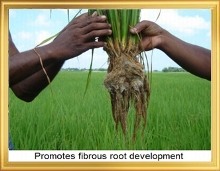 |
| |
Potassium |
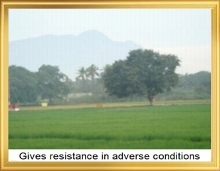 |
- Potassium enhances the ability of the plants to resist diseases, insect attacks, cold and other adverse conditions.
- It plays an essential part in the formation of starch and in the production and translocation of sugars, and is thus of special value to carbohydrate-rich crops.
- Involves in working of enzymes.
- Helps in production and movement of photosynthates to sink.
- Helps in proper uptake of other nutrients.
- Influences tillering or branching of plant and size and weight of grain.
- Over 80 per cent of the absorbed potassium by the plant is found in straw. Need for potassium is most likely to occur on sandy soils.
|
| Calcium |
|
- Calcium combines with pectin in the plant to form calcium pectate, which is an essential constituent of the cell-wall.
- It also promotes the activity of soil bacteria concerned with the fixation of free nitrogen or the formation of nitrates from organic forms of nitrogen.
- Furthermore, it is necessary for the development of a good root system.
|
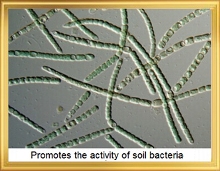 |
| |
Magnesium |
 |
- Magnesium is an essential constituent of chlorophyll.
- It is usually needed by plant in relatively small quantities. Hence its deficiency in the soil is experienced later than that of potassium.
|
| Sulphur |
|
- It involve in chlorophyll production, protein synthesis and plant function and structure.
- Sulphur forms an important constituent of straw and plant stalks.
|
 |
| |
Iron |
 |
- Iron is necessary for the synthesis of chlorophyll.
- Mainly a problem in upland soils.
|
| Zinc |
|
- Essential for the transformation of carbohydrates.
- Regulates consumption of sugars.
- The function of zinc in plants is as a metal activator of enzymes.
- Deficiency of zinc in lowland rice occurs in near neural to alkaline soils, particularly in calcareous soils.
- Availability of both soil and applied zinc is higher in upland soil than in submerged soil.
- Soil submergence causes decrease in zinc concentration in the soil solution.
- Rice crop removes 30-40 g Zn per tonne of grain.
|
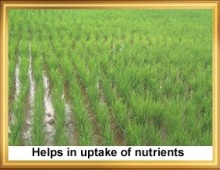 |
| |
Boron |
 |
- Boron facilitates the translocation of sugars by forming sugar borate complex.
- It involves in cell differentiation and development since boron is essential for DNA synthesis.
- Also involves in fertilization, hormone metabolism etc.
|
| Copper |
|
- It is an important constituent of plastocyanin (copper containing protein).
- It is also a constituent of several oxidizing enzymes.
- Important for reproductive growth.
- Aids in root metabolism and helps in the utilization of proteins.
|
 |
| |
Manganese |
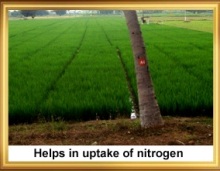 |
- It is an activator of nitrite reductase and many respiratory enzymes.
- It is necessary for the evolution of oxygen (photolysis) during photosynthesis.
- Functions with enzyme systems involved in breakdown of carbohydrates, and nitrogen metabolism.
- Soil is a source of manganese.
|
| Silicon |
|
- It is an important element for improving plant health and disease resistance.
- It has the potential to significantly decrease the susceptibility of certain plants to both biotic and abiotic diseases.
- Beneficial for the growth of paddy.
- An adequate supply of silica is essential for paddy to give a good yield by increasing the strength and rigidity of cells.
- Plant roots take up their silica as silicic acid.
- It is possible that the amount taken up by paddy is equal to the amount of silicic acid present in the water the roots absorb, so that the greater the amount of water transpired, the greater their uptake of silica.
|
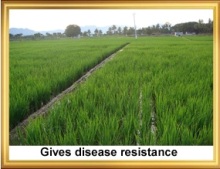 |
| |
Top |
| Nutritional Disorders |
Nutrient Deficiencies and Toxicities |
| |
Nitrogen |
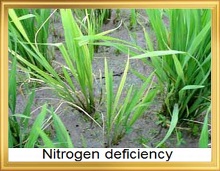

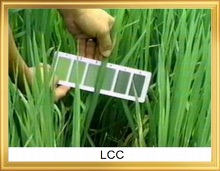 |
Deficiency Symptoms
- Stunted growth and yellowish plants.
- Older leaves of whole plants are yellowish green.
- Old leaves sometimes all leaves become light green.
- Deficiency symptoms first appear at the tip and progress along the midrib until the entire leaf is dead.
- Tips become chlorotic. Leaves narrow, short, erect and lemon-yellowish green.
Corrective measures
- Do not apply large amounts of N to less responsive varieties
- Choose suitable plant spacing for each cultivar.
- Adjust the number of splits and timing of N applications according to the crop establishment method.
- Keep the field flooded to prevent denitrification but avoid N losses from water runoff over bunds immediately after fertilizer application.
- Soil application of 25 % excess of recommended N.
- Foliar application of Urea 1% at weekly interval till the symptoms disappear
N management in paddy with leaf colour chart (LCC).
- Yellowing of leaves in paddy indicates the deficiency of nitrogen, but it is difficult to decide the quantity of nitrogen to be applied based on the extent of yellowing.
- The actual requirement of nitrogen by the crop can be correctly assessed by leaf colour chart.
- The leaf colour chart consists of 6 -7 green strips, 1st strip with light green colour and the last strip (6th or 7th) with dark green colour, and in between strips (2nd to 5th) are with varying intensity of green colour.
Use of leaf colour chart
- Select fully opened disease free new leaf i.e. third leaf from the top as index leaf in paddy plant for assessing the leaf colour and ten leaves to be selected from ten plants in the field.
- Match the colour of the selected leaves by keeping the middle of the leaves on the colour strips of leaf colour chart and assess the colour intensity ( LCC value) during morning hours (8-10 am).
- Assess the intensity of leaf colour each time at a particular time by a particular individual.
- Take average of two if the leaf colour matches between two colour strips of the chart.
- Commence the assessment of the leaf colour with LCC at 14 DAT in transplanted rice or 21 DAS in direct seeded rice and continue up to flower initiation/heading at an interval of 7-10 days.
- Critical LCC value varies with the type of paddy genotypes. LCC critical value is 3.0 in low N response cultures. In Tamilnadu LCC critical value is 3.0 in low N response cultures like White Ponni and 4.0 in other cultivars and hybrids.
- Assess the average LCC values of 10 leaf samples. When the average LCC value of ten leaves or when the LCC values of five or more leaves found below the critical LCC limit fixed for that genotype, then top dress nitrogen depending on the crop growth and stage.
- If six or more leaves read below the specified threshold value, N can be applied @ 35 kg N/ha in dry season and 30 kg N/ha in wet season per application per ha. If the value is above the threshold value, there is no need for top dressing during that week.
Nitrogen toxicity symptoms:
- Plants are dark green in colour
- Abundant foliage
- Restricted root system
- Flowering and seed setting may be retarded.
Nitrogen sources
Farmyard manure, Green manures, Biofertilizers (Rhizobium, AzollaAzospirillum, Azotobacter) Castor cake, Neem cake, Urea, Diammonium phosphate, Ammonium nitrate, Ammonium sulphate. |
| Phosphorus |
|
Deficiency symptoms
- Plants stunted with reduced tillering.
- Leaves narrow, short, very erect ‘dirty’ dark green.
- Older leaves turn brownish red and purple colors develop in leaves.
- Stems thin and spindly.
- Poor tillering/branching.
- Poor root growth.
Corrective measures
- Application of phosphobacteria to the soil as seed coating or as seedling dip.
- Application on P fertilizer 15-30 kg P/ha.
- Rock phosphate broadcast before flooding when soil pH is low.
Phosphorus sources:
Farmyard manure, Biofertilizers (Phosphate solubilizers) Castor cake, Neem cake,Super phosphate (single),Super phosphate (Double),Super phosphate (Triple), Basic slag, Mussori, Diammonium phosphate (SPIC), Ammonium phosphate (Gromor)
Phosphorus toxicity (Injury due to excess P application)
1. Fixed in soil – not available to plants
2. Leads to Zinc deficiency |

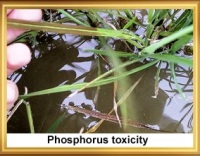 |
| |
Potassium |
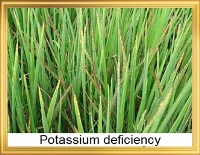
 |
Deficiency symptoms
- Dark green plants with yellowish.
- Brown leaf margins and brown necrotic spots on the tips of older leaves.
- Rusty brown spots on the panicles and poor grain formation.
- Weak stem leads to lodging.
Corrective measures:
- Soil application of 25% excess of recommended K.
- Foliar application of 1% KCL
- Spread and incorporate the straw evenly over the field before burning. Ash from burnt straw heaps should also be spread over the field.
Potassium sources
Farmyard manure, Castor cake, Neem cake, Muriate of potash (KCl), Potassium sulphate
Injury due to excess K application
- Excess of this element tends to delay maturity
- Leads to calcium magnesium and iron deficiencies.
|
| Calcium |
|
Deficiency symptoms
- White or bleached, rolled, and curled tips of youngest leaves.
- Necrosis along the lateral margins of leaves.
- Old leaves turn brown and die.
- Stunting and death of growing points
Corrective measures:
- Apply farmyard manure or straw (incorporated or burned) to balance Ca removal in soils containing small concentrations of Calcium Fertilizers.
- Apply CaCl2 or Ca containing foliar sprays for rapid treatment of severe Ca deficiency.
- Apply gypsum in Ca deficient high pH soils,e.g., on sodic & high K soils.
- Apply lime on acid soils to raise pH and Ca availability.
- Apply pyrites to mitigate the effects of NaHCO3- rich water on Ca uptake.
Calcium sources:
Farmyard manure, Calcium chloride. Gypsum, dolomite, lime, pyrites, single superphosphate or triple superphosphate. |
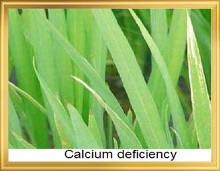
|
| |
Magnesium |
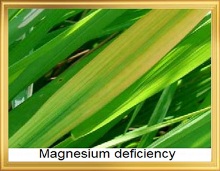
|
Deficiency symptoms:
- Leaf chlorotic with white tips.
- Pale-colored plants with orange-yellow interveinal chlorosis on older leaves and later on younger leaves.
- Chlorosis progresses to yellowing and finally necrosis in older leaves in severe cases wavy and droopy leaves.
- Reduced number of spikelets and grain quality.
Corrective measures:
- Rapid correction of Mg deficiency symptoms is achieved by applying a soluble Mg source such as kieserite or Mg chloride.
- Foliar application of liquid fertilizers containing Mg (e.g.,Mgcl 22%)
Magnesium sources:
Farmyard manure, Magnesium chloride, dolomite. |
| Sulphur |
|
Deficiency symptoms:
- Yellowing or pale green whole plant.
- Young leaves chlorotic or light green colored with the tips becoming necrotic.
- Lower leaves not showing necrosis.
- Leaves pale yellow.
- Effect on yield is more pronounced when S deficiency occurs during vegetative growth.
Corrective measures:
- Incorporate straw instead of completely removing or burning it. About 40-60% of the S contained in straw is lost during burning.
- Carry out dry tillage after harvesting, to increase the rate of sulfide oxidation during the follow period.
- Applying 15-20 kg S ha-1 gives a residual effect that can supply the S needed for two subsequent rice crops.
Sulphur sources:
Ammonium sulfate, Single superphosphate, Potassium sulfate, gypsum and S-coated urea. |

 |
| |
Iron |
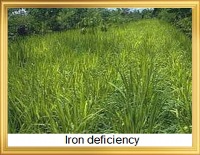
 |
Deficiency symptoms:
- Interveinal yellowing.
- Chlorosis of whole leaves and emerging leaves.
- Entire plants becomes chlorotic.
Corrective measures:
- Apply solid FeSO4 (30 kg Fe/ha) next to rice rows or broadcast.
- Foliar applications of FeSO4 (2-3% solution) 2-3 applications at 2 week intervals.
- Use acidifying fertilizers (e.g., ammonium sulfate instead of urea) on high-pH soils.
- Grow tolerant cultivars for low soil Fe availability.
Iron sources:
Soluble ferrous sulfate (20-33% Fe), ferrous ammonium sulfate (14% Fe), and iron chelates (5 to 14% Fe). |
| Zinc |
|
Deficiency symptoms:
- Dusty brown spots on upper leaves.
- Stunted growth of plants.
- Decreases tillering and increase spikelet sterility.
- Leaf base of younger leaves become chlorotic brown and blotches/streaks on lower leaves.
Corrective measures:
- Broadcast ZnSO4 in nursery seedbed.
- Dip seedlings or presoak seeds in 2-4% ZnO suspension.
- It is enough to apply 12.5 kg zinc sulphate /ha, if green manure (6.25 t/ha) or enriched FYM, is applied.
- Apply 25 kg of zinc sulphate with 50 kg sand before transplanting.
- Apply 5-10 kg Zn ha-1 as Zn sulfate, apply 0.5 – 1.5 % ZnSO4/ha as a foliar spray at tillering (25-30 DAT), 2-3 repeated applications at intervals of 10-14 days.
- Zn chelates (e.g., Zn-EDTA) can be used for foliar application.
Zinc sources:
Zinc sulfate, Zinc carbonate, Zinc chloride, Zinc chelate, Zinc oxide.
Zinc toxicity symptoms:
Excess zinc commonly produces iron chlorosis in plants. |
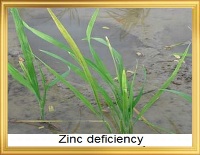
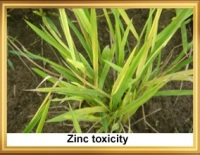 |
| |
Aluminium |
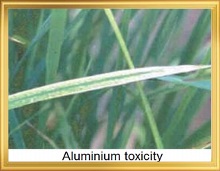
|
Toxicity symptoms:
- Orange-yellow interveinal chlorosis on leaves followed by leaf tip death and leaf margin scorch.
- Necrosis of chlorotic areas during severe Al toxicity.
- Stunted and deformed roots in susceptible cultivars.
Corrective measures:
- Delay planting until pH has increased sufficiently after flooding (to immobilize Al).
- Plant Al-tolerant cultivars (IR43, CO 37, and Basmati 370) which accumulate less Al in their foliage and take up and use Ca and P efficiently in the presence of Al.
- Apply 1-3 t lime/ha to raise pH.
|
| Boron |
|
Deficiency symptoms:
- White and rolled leaf tips of young leaves.
- Reduction in plant height.
- Death of growing points, but new tillers continue to emerge during severe deficiency.
- Plants unable to produce panicles if affected by B deficiency.
Corrective measure:
- Avoid excessive leaching (percolation).
- Apply B in soluble forms (borax) for rapid treatment of B deficiency (0.5-3 kg B/ ha), broadcast and incorporated before planting, top dressed or as foliar spray during vegetative rice growth.
Boron sources:
Anhydrous borax, Fertilizer borate, borax.
Toxicity symptoms:
- Chlorosis of tips and margins of older leaves as initial symptoms.
- Dark brown elliptical spots on discolored areas two to three weeks later followed by browning and drying up.
- Necrotic spots prominent at panicle initiation.
Corrective measures:
- Plant B-toxicity tolerant varieties (e.g., IR42, IR46, IR48, and IR 54).
- Use surface water with a low B content for irrigation.
- Plough when the soil is dry so that B accumulates in the topsoil. Leach with water containing a small amount of B.
|

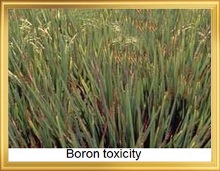
|
| |
Copper |
 |
Deficiency symptoms:
- Leaves develop chlorotic streaks on either side of the midrib.
- Dark brown necrotic lesions on leaf tips, Leaves often bluish green and chlorotic near the leaf tip.
- New leaves do not unroll and the distal parts of leaves maintain a needle like appearance.
- Reduced tillering and increased spikelet sterility
Corrective measures:
- Dip seedling roots in 1% CuSO4 suspensions for 1 hr before transplanting.
- Avoid overliming of acid soils because it may reduce Cu uptake.
- On Cu-deficient soils, apply CuO or CuSO4(5-10 kg Cu/ha at 5-year intervals) for long-term maintenance of available soil Cu (broadcast and incorporate in soil).
Copper sources:
Cupric sulfate, Cu oxide |
| Manganese |
|
Deficiency symptoms:
- Pale greyish green interveinal chlorosis spreads from the tip to the leaf base.
- Necrotic brown spots develop later and leaf becomes dark brown.
- Newly emerging leaves short, narrow and light green.
- Deficient plants shorter, with fewer leaves, weigh less, and smaller root system at tillering.
Corrective measures:
- Apply MnSO4 or finely ground MnO (5-20 kg Mn/ha) in bunds along rice rows.
- Apply foliar MnSO4 for rapid treatment of Mn deficiency(1-5 kg Mn/ha in about 200 L water/ha).
- Use acid-forming fertilizers, e.g., ammonia sulfate [(NH4)2SO4] instead of urea.
Manganese sources: Mn sulfate, Mn chloride
Toxicity symptoms:
- Yellowish brown spots between leaf veins, extending to the whole interveinal area.
- Brown spots on veins of lower leaf blades and leaf sheaths.
- Leaf tips dry out eight weeks after planting.
- Chlorosis of younger (upper) leaves, with symptoms similar to those of Fe chlorosis.
- Stunted plants, reduced tillering and sterility results in reduced grain yield.
Corrective measures:
- Coat seeds with oxidants (e.g., Ca peroxide) to improve germination and seedling emergence by increasing the supply of O2.
- Apply lime on acid soils to reduce the concentration of active Mn.
- Mn uptake is reduced in the presence of ammonia.
|
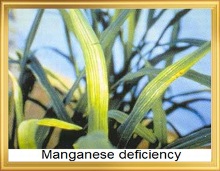
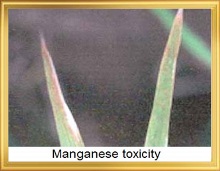
|
| |
Silicon |
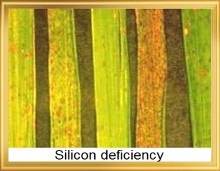 |
Deficiency symptoms:
- Leaves and culms become soft and droopy thus increasing mutual shading.
- Reduces photosynthetic activity.
- Severe Si deficiency reduces the number of panicles m2 and the number of filled spikelets per panicle.
- Si-deficient plants are particularly susceptible to lodging.
Corrective measures:
- For more rapid correction of Si deficiency, granular silicate fertilizers should be applied: Calcium silicate 120-200 kg/ha , Potassium silicate 40-60 kg/ha.
- In the long term, Si deficiency is prevented by not removing the straw from the field following harvest. Recycle rice straw (5-6% Si) and rice husks (10% Si).
- Avoid applying excessive amounts of N fertilizer, which increases yield and total uptake of N and Si, but also decreases the Si concentration in straw because of excessive biomass growth.
Silicon sources:
Calcium silicate, potassium silicate, blast furnace slag. |
| Sodium |
Toxicity symptoms:
- Leaves short, narrow and brittle.
- Leaves initially show dark green colour, later become bleached and turn yellow to pink and necrotic
Corrective measures:
Soil application of gypsum at 100-200 kg/ha and leach with water. |
| Sulphur |
Toxicity symptoms:
- Interveinal chlorosis of emerging leaves.
- Coarse, sparse, dark brown to black roots.
- Fresh uprooted rice has poorly developed root systems with many black roots.
- Increased occurrence of diseases.
Corrective measures:
- Apply K, P, and Mg fertilizers.
- Apply Fe (salts, oxides) on low-Fe soils to increase immobilization of H2S as FeS.
- Avoid continuous flooding and use intermittent irrigation in soils that contain large concentrations of S.
- Carry out dry tillage after harvest to increase S and Fe oxidation during the fallow period.
|
| Top |
| Organic Manures |
(1) Green Manuring
(2) Biofertilizer
(3) Organic Manuring Practices
|
| Green Manuring |
| Green Manure |
|
| Green Manures |
Seed rate (kg/ha) |
Green biomass (t/ha) |
| Sithagathi (Sesbania speciosa) |
30 – 40 |
15-18 |
| Dhaincha (Sesbania aculeata) |
50 |
25 |
| Manila Agathi - Sesbania rostrata |
40 |
20 |
| Sunnhemp (Crotalaria juncea) |
25-35 |
13-15 |
| Wild Indigo (Tephrosia purpurea) |
15-20 |
6-7 |
|
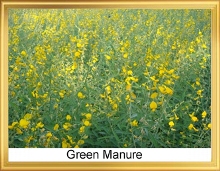 |
| |
Green Leaf Manures |
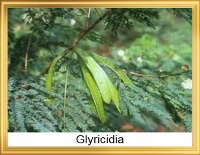 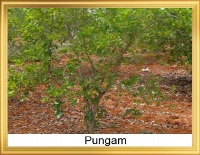
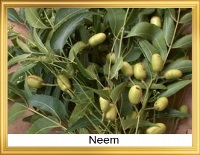  |
- Glyricidia (Glyricidia maculata Syn. G.sepium)
- Pungam (Derris indica Syn. Pongamia glabra)
- Ipomoea cornea
- Neem (Azadirachta indica)
- Sesbania grandiflora
|
| Advantages of green Manuring |
- Green manuring builds up soil structure and improves tilth.
- Improves aeration in rice soils by stimulating activities of surface film of algae and bacteria.
- Harbour N fixing bacteria, rhizobia in root nodules and fix atmospheric N
(60 to 100 kg N/ha).
- Promotes formation of crumbs in heavy soils leading to aeration and drainage.
- Vitamin and protein content of rice increased.
|
| Biofertilizer |
- Biofertilizers are ready to use live formulates of such beneficial microorganisms which on application to seed, root or soil mobilize the availability of nutrients by their biological activity in particular, and help to build up the micro-flora and in turn the soil health in general.
- Bio-fertilizers are eco friendly and are environmentally safe.
- They form not only part of integrated nutrients but are of low cost.
- The bio-fertilizers used for rice crop are azolla, Blue green algae, Azotobacter, Azospirillum, Phosphobacteria, Phosphate solubilisers and Mycorhiza.
|
| Azolla |
|
- Azolla is a fresh water fern.
- 0.5 -1 t of biomass of azolla /ha is used for paddy in two ways either as green manure before transplanting, or as dual crop in 7 DAT.
- It releases the nitrogen to the rice crop only after complete decomposition (8-10 days).
- It also enhances the availability of phosphorus than chemical fertilizer on 40th day besides improving the C:N ratio of soils.
|
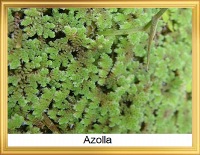
|
| |
Blue green algae |
 |
- These are photosynthetic prokaryotic microorganisms capable of fixing atmospheric nitrogen.
- It can be applied to rice crop at 10 kg/ha on 10 DAT. ‘Algalisation’ increases the nitrogen content of both grain and straw besides increasing soil fertility.
- It can fix 20-30 kg N/ha.
|
| Azotobacter |
|
- Azotobacter is a free living nitrogen fixing bacteria.
- It can be applied to rice through seed or seedling or soil.
|
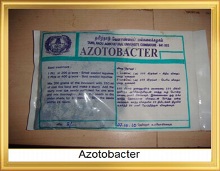
|
| |
Azospirillium |
 |
Inoculation with Azospirillum promotes early tillering and also the growth of rice and significantly increases filling rate of grain and the grain weight per plant at harvest. |
| Phosphobacteria |
|
- A large proportion of the phosphatic fertilizer applied to soil is fixed by conversion into insoluble forms of phosphorus which is not available to plants.
- Only 20-25 per cent of phosphorous is available to plants. This insoluble and unavailable phosphorus remains unutilized by plants in soil.
- The bacteria, which dissolve the undissolved form of phosphorus is called 'Phosphobacteria'.
- The organic acids produced by phosphobacteria dissolve the insoluble (fixed) form of phosphorous in soil and make it available to plants.
|
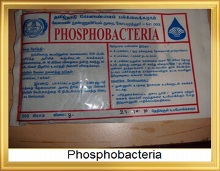
|
Azospirillium,Phosphobacteria,Azotobacter
|
Number of packets/hectare is
| Method of application |
Number of Packets/ha |
| Seed treatment |
5 |
| Nursery application |
10 |
| Seedling dip |
5 |
| Main field (Soil application) |
10 |
| Total |
30 |
|
| |
Mycorrhiza |
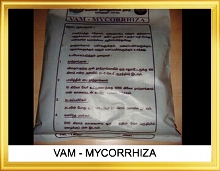 |
- It occurs naturally in low land and upland rice. It mobilizes the phosphorus required by rice.
- It also provides nutrients such as iron, zinc, copper, manganese etc.
- Endomycorrhiza are obligate symbionts and can be maintained only on live plants inoculated with spores of a species and collecting the pieces of roots with soil.
- The root biomass heavily infected by a specific mycorrhizal fungus serves as the inoculum for subsequent plots.
|
| Phosphate Solubilisers |
|
- This type of biofertilizers solubilises phosphates in the soil and render them in available form for low land and upland rice.
- Bacteria like Bacillus megatherium var phosphaticum, Bacillus polymixa, Pseudomonas fluorscens, Pseudomonas striata fungi like Pencillium digitatum, Aspergillus niger, Aspergillus awamori were found to have a strong phosphate dissolving ability.
- For semi-dry rice, hardened seeds are treated with Pseudomonas fluorscens 10g/kg of seed.
|

|
| |
Methods of application of Biofertilizer |
 |
- Bacterial biofertilizers are supplied as carrier based inoculants.
- Peat or lignite is used as carrier material.
- Carrier based bacterial inoculants are applied by the following methods.
- Seed treatment.
- Seedling root dip and
- Main field application
|
| Seed Treatment |
|
- One package of the inoculant is mixed with 200ml of rice kanji to make slurry.
- The seeds required for an acre are mixed in the slurry so as to have a uniform coating of the inoculant over the seeds and then shade dried for 30 minutes.
- The shade dried seeds should be sown within 24 hours.
- One packet of the inoculant (200g) is sufficient to treat 10 kg of seeds.
|
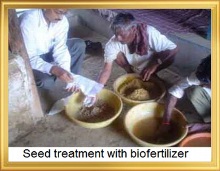
|
| |
Seedling Root Dip |
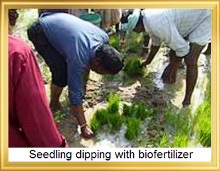 |
- This method is used for transplanted crops.
- Two packets of the inoculant is mixed in 40 litres of water.
- The root portion of the seedlings required for an acre is dipped in the mixture for 5 to 10 minutes and then transplanted.
|
| Main field Preparation |
|
Four packets of the inoculant is mixed with 20 kgs of dried powdered farm yard manure and broadcast in one acre of main field just before transplanting. |

|
| |
Combained application of Bacterial Biofertilizers |
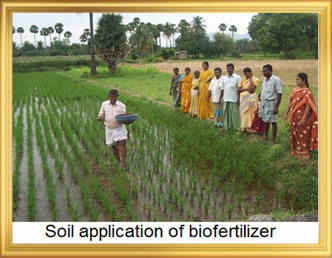 |
Phosphobacteria can be mixed with Azospirillum. The inoculants should be mixed in equal quantities and applied as mentioned above. |
| Organic Manuring practices |
| TamilNadu |
|
- In nursery, apply 1 tonne of fully decomposed FYM or compost to 20 cents nursery and spread the manure uniformly on dry soil.
- In main field, apply 12.5 t of FYM or compost or green leaf manure @ 6.25 t/ha.
- If green manure is raised @ 20 kg /ha in situ, incorporate it to a depth of 15 cm using a green manure trampler or tractor.
- In the place of green manure, press-mud / composted coir-pith can also be used.
|
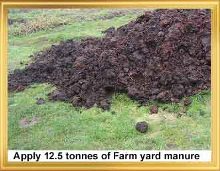
 |
| |
Kerala |
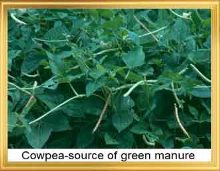 |
- Apply organic manure in the form of farmyard manure or compost or green leaf @ of 5 t/ha and incorporate into the soil while ploughing.
- Cowpea may be raised as an intercrop in dry seeded low land (semi-dry) rice by sowing 12.5 kg seed/ha along with rice to serve as a source of green manure.
- When the rice field gets submerged with the onset of southwest monsoon, cowpea at the age of about six weeks and at active vegetative stage decays and gets self-incorporated in the soil adding substantial quantity of green manure.
- Such a system of concurrent growing of cowpea also reduces weed pressure in semi-dry rice.
|
| Karnataka |
|
Drill sown paddy :
- Sow sunhemp green manure seeds @10kg/ha mixed with paddy seeds.
- Carry out hodta operation (Planking) in standing water after 40 DAS for in situ incorporation of sunhemp in the soil which will decompose easily and early and add to organic matter to the soil maintaining the soil fertility.
(OR)
- Ex situ incorporation of green leaf manuring of Eupatorium/parthenium/cassia and other weeds green material @ 5 t/ha in between the two paddy rows by carrying out hodta operation.
- Provides only 50% nutrients to maintain good yield.
Transplanted paddy:
Sow green manure seeds of Sesbania rostrata (@ 25kg/ha) along with the application of entire P2O5 recommended for paddy, eight weeks before transplanting of paddy, then in situ incorporate the green manure crop by carrying out hodta operation ( Planking) seven weeks after sowing. Transplant paddy seedlings after one week of incorporation along with the application of 50% recommended nitrogen for paddy. |

 |
| |
Top |
| Fertilizer Requirements |
(1) Fertilizer Requirements
|
These products are quick acting, even in cool soils and they are inexpensive. They are the most effective means of increasing crop production and supplement nutrient supply in the soil, especially to correct yield-limiting factors. |
 (1) a)Tamil Nadu (1) a)Tamil Nadu
Transplanted Puddled Low Land Rice |
|
Blanket recommendation (Kg/ha) – 150:50:50
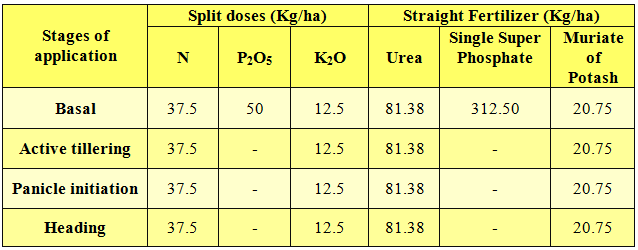
In nursery, before the last puddling apply basal application of DAP (40 kg) is recommended when the seedlings are to be pulled out in 20-25 days after sowing. For clay soils where root snapping is a problem, 4kg of Gypsum and 1 kg of DAP per cent can be applied at 10 DAS.
|
| Direct wet seeded puddled lowland rice, Dry seeded rainfed un-puddled lowland rice and Rainfed upland rice |
|
Blanket recommendation (Kg/ha) – 50:25:25

|
| Semidry System-Dry seeded rice in un-puddled low land |
|
Blanket recommendation (Kg/ha) –:75:25:37.5

|
 (b) Kerala (b) Kerala
|
|
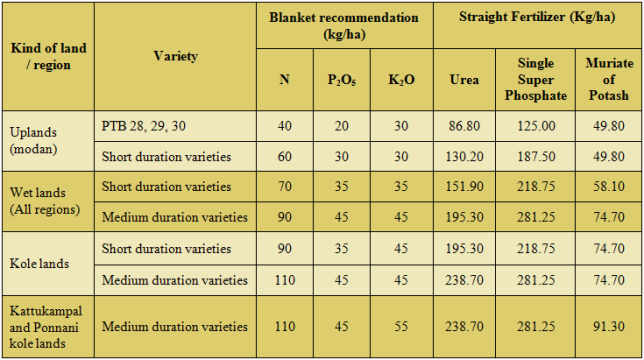
Stages of application:
1. For short duration varieties, N is applied in three equal splits viz., basal, active tillering, and active panicle initiation stages. The recommended P is fully applied as basal. K is applied in two equal splits viz., basal and active panicle initiation stages.
2. For medium and long duration varieties, N are applied in two equal splits viz., basal and active panicle initiation stages. The recommended P is fully applied as basal. K is applied in two equal splits viz., basal and active panicle initiation stages.
3. For direct seeded crop, the basal application should be done one week after sowing. |
 (c) Karnataka (c) Karnataka
|
|
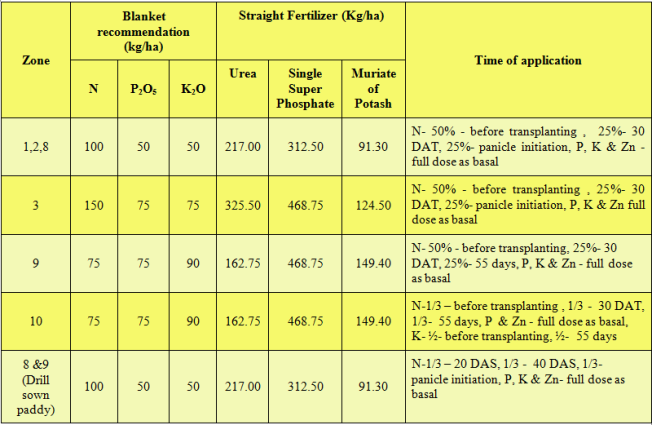
Zone 1 - North Eastern Transition Zone
Zone 2 - North Eastern Dry Zone
Zone 3 - Northern Dry Zone
Zone 4 - Central Dry Zone
Zone 5 - Eastern Dry Zone
Zone 6 - Southern dry Zone
Zone 7- Southern Transition Zone
Zone 8 - Northern Transition Zone
Zone 9 - Hill Zone
Zone 10 - Coastal Zone |
 (2) Method of Fertilizer application (2) Method of Fertilizer application
Soil application |
|
Basal application
- Apply 25 % recommended dose of N and K as basal.
- P may be applied fully as basal and incorporated.
- Apply 25 kg of zinc sulphate mixed with 50 kg dry sand just before transplanting.
- Apply 500 kg of gypsum/ha (as source of Ca and S nutrients) at last ploughing.
Top dressing
Apply 25 % recommended dose of N and K each as top dressing at active tillering, panicle initiation and heading stages. |
 |
| |
Foliar Nutrition in paddy |
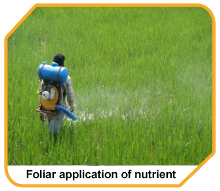 |
- In recent year’s soluble fertilizers otherwise known as foliar fertilizers like Polyfeed and Multi 'K' were introduced in rice growing states.
- Polyfeed contains 19: 19: 19 NPK with 6 micro-nutrients like iron, manganese, boron, zinc, copper and molybdenum, while multi K contains 13: 0: 46 NPK.
- These fertilizers provide nutrients to the plant by foliar application as these fertilizers are completely soluble in water.
- These fertilizers have no other impurities like sodium and chloride and they are 100 % nutrients and these nutrients are easily absorbed through the leaves.
- In certain occasions like prolonged drought, there is no scope to apply fertilizers to the soil for want of moisture. Like wise in flooded conditions due to continuous rains fertilizers could not be applied to the soil. In such special circumstances these soluble fertilizers are must to protect the crop against hunger and this forms a compulsory act of crisis management.
- And the foliar application of Speciality fertilizers plays an important role in supplying the nutrients at critical stages of flowering and grain formation.
- Under special conditions of drought and waterlogging, apply N as foliar spray.
- Urea may be applied as a low volume spray at 15% concentration using power sprayer or at 5% concentration using a high volume sprayer, the quantity applied in one application being limited to 15 kg/ha.
- Foliar spray of Urea (10 g/lit) + DAP (20 g/lit) + KCl (10 g/lit) at PI and 10 days later for all varieties.
- If deficiency symptom appears, foliar application of 0.5% Zinc sulphate + 1.0% urea can be given at 15 days interval until the Zn deficiency symptoms disappear.
|
| Growth Regulators |
|
- Foliar spray of Brassinosteriods 0.3 ppm at Panicle Initiation and Flowering stages increased the grain yield.
- For increasing the rooting under broadcast method of planting, soaking roots in 25 ppm Induction of better rooting for early establishment in rice, root dipping for 16 hours in thiamin solution.
|
 |
| Top |
| |
Integrated Nutrient Management (INM) |
 |
Integrated nutrient management (INM) aims at reducing the chemical fertilizer applied and improving its efficiency through combined use of different sources of plant nutrients such as
Fertilizers,
1. Organic manures,
2. Green manures,
3. Crop residues,
4. Biofertilisers and
5.Industrial wastes / soil conditioners in balanced proportions, depending on their availability and suitability in a specific rice ecosystem.
Sources of nutrients:
1. Organic manures / compost – 12.5 t of FYM
2. Green manures / green leaf manures / crop residues - 6.25 t/ha
3. Fertilizers – Apply blanket recommendation as per the ecosystem.
Biofertilizers:
1. Azolla –as green rmanure @ 6t /ha, as dual crop (0.5 t/ha) in 7 DAT
2. Blue green algae - 10 kg/ha on 10 DAT
3. Azotobacter /Azospirillium /Phosphobacteria - 10 packets (soil application)
4. Azophos – 20 packets (soil application)
Micronutrients:
- Apply 25 kg of zinc sulphate mixed with 50 kg dry sand just before transplanting.
- It is enough to apply 12.5 kg zinc sulphate /ha, if green manure (6.25 t/ha) or enriched FYM, is applied.
- If deficiency symptom appears, foliar application of 0.5% Zinc sulphate + 1.0% urea can be given at 15 days interval until the Zn deficiency symptoms disappear.
- Dip roots of the seedlings in 1% Zinc sulphate solution for one minute before transplanting.
|
| Top |
|

































































